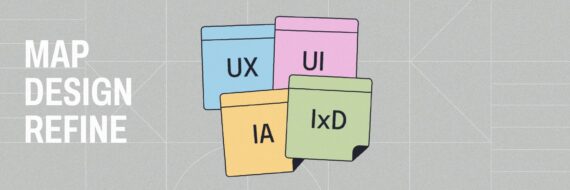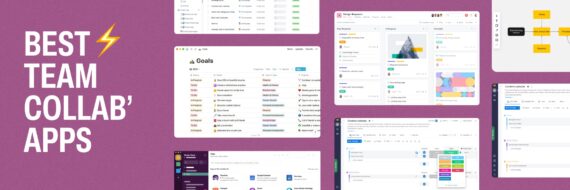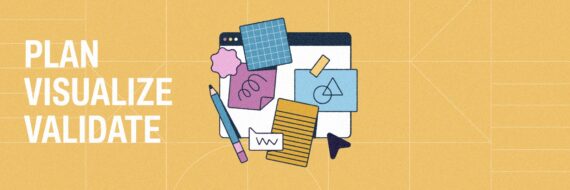Agile user experience design has all but taken over how software and websites are developed. Nowadays you can find the Agile UX process behind any of your favorite apps or sites while its emphasis on iterative, continuously improving releases makes it almost indispensable in the software-as-a-service world we all operate in.
organizations state faster product delivery as one of their key drivers for agility
The Agile mindset is based on facilitating a collaborative environment that allows for speedier and more effective development and design. There’s a reason KPMG found that nearly 70% of “organizations state faster product delivery as one of their key drivers for agility” and Forbes found that over 50% of those surveyed “reported agile approaches (specifically scrum) resulted in improved satisfaction with deliverables.”
We’ll dig into why Agile methodologies make a big difference in creating stronger UX.
What is Agile UX design?
Agile UX design is really the meeting point of an Agile project management methodology and your standard user experience design practices. A two-for-one if you will. Breaking it down further, the Agile development process is an iterative, cyclical approach that’s most often used in the world of software development. UX design is the process of crafting and shaping a site, app or product to create an exceptional and seamless user experience.
Agile UX meaning then is the intersection of both these processes; an iterative approach to improve UX.
Rest assured, we’ll dig beneath the surface in the following sections to sharpen the concept further.
What is Agile development?
Agile development, as mentioned, is chiefly a project management philosophy centered around collaboration and iteration. But what does that mean exactly? Well, since Agile is as much a mindset as it is a workflow model it’s instructive to take a look at another popular model, the waterfall approach, to get a better understanding.

With waterfall methodologies, development chugs along in a linear, sequential fashion with one phase starting only when the previous one finishes. You can think of it almost as an assembly line where the end is predestined and each stop along the way is its own function. Each step builds on the previous one with little direct collaboration and essentially zero deviation from the plan. Backtracking is of course difficult and time-consuming with this method.
Agile, meanwhile, takes a distinctly different tack and one that’s particularly well suited to the dynamics of software development. With an Agile approach, the process is broken down into smaller, more manageable increments aka sprints. Once the sprint planning is complete, collaboration and communication rule the day as teams work together to brainstorm, ideate, develop and build solutions. This is followed by evaluating, usability testing and validating en route to launching the feature or site…and then it happens all over again. Continuous improvement is the name of the game.
The Agile Manifesto ties it up and puts a bow on it nicely:
- Individuals and interactions over processes and tools
- Working software over comprehensive documentation
- Customer collaboration over contract negotiation
- Responding to change over following a plan
So how does UX design differ from agile development?
One is the workflow and philosophy behind it — Agile — while the other is the work itself — UX design. A better way to look at this though is that one facilitates the other, where Agile methodologies (i.e., Scrum, Kanban, Lean UX, etc.) are what help you create better UX.
That said, what is UX design exactly? We can’t leave you hanging without a definition:
🎬 Learn what Slickplan can do!
We filmed a short video to show you exactly how to use Slickplan
Integrating UX and Agile development principles
Bringing agile development principles and UX together is a matter of shifting the way in which you tackle and think about projects. In that sense, any team can become an Agile team. Agile is the means to the end and integrating it into your product development team’s process can fundamentally transform your product for the better because responding to change — aka finding solutions — is at its core.
For UX designers, this might look like more customer touchpoints, incorporating collaborative software and UX design tools as well as adding regular cross-functional meetings with other team members to the schedule. Powwows with other designers, engineers, content strategists and writers are crucial in effective Agile UX product development because the user experience is the responsibility and end result of the whole team’s collaborative efforts, not solely the UX designer. When it comes to sprint planning, or deciding what to work on, the focus could be on anything from stakeholder input to design discovery to working on a feature from the backlog and beyond. All of which could stretch across multiple sprints in the project window.
When it comes to sprint planning, or deciding what to work on, the focus could be on anything from stakeholder input to design discovery to working on a feature from the backlog and beyond. All of which could stretch across multiple sprints in the project window.
At the end of each sprint, Agile teams hold a retrospective meeting or “retro” to discuss the wins, losses, achievements and obstacles encountered. Often, these retros reveal opportunities and approaches that can be used in the next sprint and so the cycle goes, improving with each incarnation.
That all sounds well and good but it’s worth looking at the pros and cons to see if an Agile process is really for you.
Agile user experience design pros 👍
Accountability
The fact that Agile software development requires teamwork across multiple disciplines and departments means accountability is built into the process. In a collaborative environment, you have to be able to trust your team members are doing their part to the best of their abilities.
Adaptability & Flexibility
Because Agile projects are broken down into smaller tasks or projects and don’t move sequentially, it’s easy to adapt to changes that arise along the way. That can be anything from new information to new tech to user or customer feedback and all of it can be integrated into the current sprint on the fly or added to a future one.
Encourages a user-centered approach
Working software over comprehensive documentation is a guiding principle of the Agile mindset. Working software means more than just functionality, it means software that works well for the end-user. Working on smaller, more specific elements in each design sprint, with team members from multiple disciplines, means you stay focused on the user.
Deeper, more holistic understanding of the task or problem
Leaving everything solely to your UX designer or UX team means you’re subtracting key insights at a time when they’re potentially needed most. Including stakeholders and interdepartmental teammates until the end means you’re able to pull from their respective wells of knowledge in solving the problem or working through a task.
Speed
Really this is part and parcel of a workflow that’s infinitely adaptable. The quicker you can adjust to change in the marketplace, the quicker you can get your new and improved product to that market.
Agile user experience design cons 👎
Friction and managing culture
You’ve heard the phrase “too many cooks in the kitchen”? Well, that’s a potential drawback of Agile. Having too many people involved can certainly slow things down, having too many people involved with separate interests or working towards a different goal can be disastrous. Agile UX relies heavily on teams working together through every phase of the sprints; If that is lost, then so is the project’s progress.
Stakeholder interference
Stakeholder involvement is good…up to a certain point. The goals of stakeholders and the goals of the product team don’t always align. The former is often profit and sales-focused while the latter is driven by functionality and design. In the worst-case scenarios, you can have a higher-up demanding they approve each element, bogging down the process along the way.
Lack of ownership
Because work is shared and collaboration is the centerpiece, each member of the team can feel like they don’t really “own” any part of the process. Product owners and scrum masters are there to guide the work but a feeling of ownership on the development team can diminish quickly beyond them.
Prioritization
Sorting out what’s important in the backlog or what’s needed to get you to a minimum viable product (MVP) is the function of proper prioritization — and having a capable person making those decisions. If the product manager or owner struggles here, it throws a wrench into the whole system. Will the work still get done? Sure. But it won’t necessarily be what the user needs right away.
Overiteration
Sometimes something is just done and doesn’t need more attention. The difficulty with a workflow that emphasizes iteration is that it’s hard to tell when to stop the cycle and move on.
The Agile UX process explained
And finally, after much pomp & circumstance, we’re at the pièce de résistance; the Agile UX process, step-by-step.
Actually, we breezed through this at the top but here we’ll get into the details.
Before getting into the steps though, it’s important to have your team defined and that means more than just the product team. When bringing on design pros, for example, make sure you’re asking the right UX designer interview questions. Beyond that, an Agile team needs a product owner and scrum master, or Agile coach, in order to function properly and adhere to the guidelines of the Agile manifesto discussed earlier.
Look at Agile as the philosophy and a scrum master as the person who actually implements it.
User research
Nothing, we mean nothing, in the product development process should start without user research and fully formed user personas. How do you know what you’re going to create without an idea of who you’re creating it for? Furthermore, your research should result in a user journey map that visualizes all the touchpoints and interactions a user or customer will have with your product, app or site. Having this big picture view helps guide what you end up working on in your sprints.
Develop user stories
A user story is a simple one or two-sentence statement from the end-user perspective about a feature or end goal. The point of them is to illustrate how your product will eventually deliver value to a user or customer.
User stories can relate to any aspect of your product and are generally written by the product owner. From there they get thrown into a backlog to be worked on in order of importance.
Sprint planning
Before you can run anywhere, you have to plan the route. Sprint planning, led by your Scrum master, is where each sprint starts. You’ll pull from the user stories you’ve developed, user feedback, stakeholder or team insights and beyond to chart the course for a sprint. This is where having a keen sense of what’s critical to the end-user is crucial because this is where prioritization happens. Typically sprints will last 2 to 4 weeks.
Design and build
With a plan in hand, it’s time for the design team and others to get crackin’ on the agreed-upon deliverables. This is where you’d move from wireframes to usable prototypes.
Test
With a working prototype of a feature or piece of software ready to go, user testing is the next step. Since you’ve done your user research at this point, you know exactly who your target audience is and therefore who you need to tap for testing.
Launch & evaluate
After you’ve tested the feature with a limited number of internal and external users, you can release it to the public.
You’re never really done evaluating so you’ll want to set specific KPIs that establish clear benchmarks for success. It could be conversion, bounce rate, views, visit length or anything else that matters to you. Just make sure it’s measurable.
Retro
With the sprint now complete, the Scrum master and product owner should bring the team together to chat about what worked and what didn’t as well as talk through wins, losses, accomplishments and obstacles faced throughout the sprint.
Repeat
Product design, interaction design and everything else that goes into UX design is continual work in progress. Once you finish one cycle, be ready for another sprint planning session for the next round of Agile experience design.
An Agile UX workflow example

Think visually. Improve UX with Slickplan
Build intuitive user flows, stronger customer journeys and improve information architecture.
Final points on the Agile UX design process
If a better product and a better overall user experience are what you’re after, there’s arguably no better approach than Agile to bring those goals to life. It creates a ripple effect where stronger teams, working in close collaboration on a common goal, can create stronger software, sites, apps and products.






 X
X

